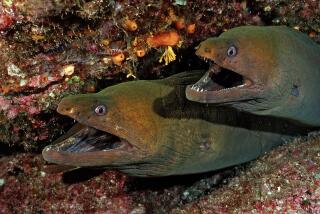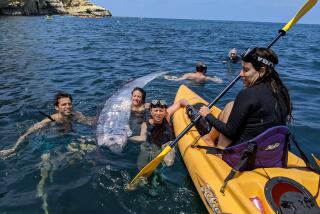Warning lights of the sea
Aboard the New Del Mar — A long night scouring a deep, dark ocean is proving uneventful -- until the luminous red dots begin drifting across the sonar screen.
Banter in the wheelhouse suddenly stops and grubby fingers point to the dots clustered along the bottom, as if trying to locate the enemy.
On deck, a fisherman lurches forward as his rod dips seaward. Another fisherman is jerked against the rail, then another.
“What else can it be?” says Capt. Ricky Carbajal of the vessel New Del Mar, which is pitching in a brisk wind, five miles beyond the Palos Verdes Peninsula.
It can only be the same bizarre denizen that has been turning up in large numbers throughout Southland waters: Dosidicus gigas, a.k.a. Humboldt, or jumbo, squid.
It is a colossal cephalopod that reaches 7 feet long, can weigh more than 100 pounds, and jets through the water at speeds up to 25 mph.
It has probing arms and tooth-lined tentacles, a raptor-like beak and an insatiable craving for flesh -- any kind of flesh, even that of humans.
It shows up briefly off California every four or five years, spurred by a warm current or some other anomaly, providing a boon for sportfishing businesses.
But amid this latest influx, to points as far north as Bodega Bay, there is a deepening concern among scientists that Humboldt squid are entrenching themselves off California, and may expand northward, eating their way through fisheries as they go. The same thing is happening in the Southern Hemisphere, where squid are being blamed for depleting the hake fishery off Chile.
The first verified capture off Alaska occurred three years ago. A year later, mass strandings made news in British Columbia, where wolves on outer island beaches were seen gnawing on rubbery squid carcasses.
Strandings and the subsequent deaths of squid, such as those along Orange County beaches in March 2005, have historically preceded infestations of local waters. In other words, these peculiar beings, which have a life span of less than two years, seem on their way to establishing residence along the length of the eastern Pacific.
“We really need to mount a research initiative soon,” warns William Gilly, a professor at Stanford University’s Hopkins Marine Station.
The reasons for the phenomenon have not been pinned down, although gradual ocean warming, pollution and over-fishing of large predators are suspected factors.
Nor is it known what the ramifications might be. But there is already proof that the squid are ingesting small rockfish, anchovies, sardines and much smaller market squid, which is the type prized as calamari.
IN fact, very little is known about Humboldt squid because they spend most of their lives at depths of 650 to 3,000 feet.
But when they rise, they can provide some big surprises.
Four divers found that out when they tried to document the squids’ behavior in the Sea of Cortez 17 years ago. While a non-diving passenger battled to land a 14-foot thresher shark on rod-and-reel, Alex Kerstitch of Arizona and three friends submerged in the nighttime sea, carrying cameras. The divers settled near the dim fringes of the boat’s lights. They could see the weary shark being pulled toward the boat. Below, dozens of squid began flashing iridescently, red-white-red.
The flashing is carried out via millions of chromatophores within the skin, opened to reveal red, closed to reveal white; it is believed by some scientists to be a means of communication.
A five-foot squid flung itself onto the shark and tore an orange-sized chunk from its head.
Another squid zoomed forth, tentacles clasped before its beak, and snatched a long needlefish, leaving in its wake a trail of blood and scales.
The frenzy built and Kerstitch, as the lone diver shooting still photographs and with no bright movie lights to deter the predators, was set upon.
A squid grabbed his right swim fin and pulled downward. He kicked it away but another grabbed his head. The cactus-like tentacles found his neck, the only part of his body not covered with neoprene.
He bashed the squid with his dive light, far less bright than the movie lights, and it let go, but it swiped both the light and the gold chain he’d been wearing.
Another squid wrapped its tentacles around his face and chest. Kerstitch dug his fingers into its clammy body.
It slid down and around his waist and pulled him downward in pulsing bursts. Then it suddenly let go, but made off with his compression meter.
For whatever reason, the attack ceased and Kerstitch got to the surface dazed and oozing blood from neck wounds, thankful to be alive.
The incident became legendary among divers, the first of many painful but, so far, nonfatal encounters by divers with Humboldt squid.
SCIENTISTS were aware of the squid’s periodic forays into the Sea of Cortez before the Kerstitch mugging.
In 1982, Nelson Ehrhardt, a professor at the University of Miami’s Rosenstiel School of Marine and Atmospheric Sciences, embarked on a project aboard a purse-seine vessel and, in an interview three years ago, described what he saw when the boat’s large net was hauled up:
“The biomass of Dosidicus was so large that the animals could not swim or pump water through their respiratory systems, suffocating them. What was terrifying was the frenzy that this situation created.... Cannibalism took place as a natural reaction and certainly if any animal of any type, including humans, would have fallen into the net, it would have been consumed in a matter of minutes.”
Humboldt squid, which historically inhabited waters within the Humboldt current off South America, were at this time entrenching themselves in the narrow gulf that separates Baja California from the Mexican mainland.
Stanford’s Gilly, who has been studying squid in the Sea of Cortez for 28 years, knows of no reference to Dosidicus gigas before the 1950s.
Fishermen recalled strandings of large squid in the 1950s and ‘60s, and encounters with live specimens, sporadically, beginning in the 1970s.
At the same time, yellowfin tuna schools stopped venturing as far up the gulf as they once did. They might have been put off by changes in oxygen levels likely caused by agricultural runoff, which produces dense phytoplankton blooms.
Gilly has learned that Humboldt squid thrive in this oxygen minimum layer, or OML, generally at great depths. The OML contains tiny lanternfish, on which the squid rely for sustenance.
In addition, Gilly says, “Inhabiting the OML may protect juvenile or smaller Dosidicus gigas from predation” by other fish.
Furthermore, large sharks were becoming scarce because of over-fishing in the Sea of Cortez, and this might have favored the cephalopods.
A squid-fishing industry established at Santa Rosalia on the Baja California coast north of Loreto has flourished in the last decade. Hundreds of skiff fishermen depart nightly during the summer, and use multi-pronged jigs and monofilament lines to haul the beasts up, hand-over-hand.
The fishery processes 100,000 tons of squid annually, most going to Asian markets, although U.S. markets are being explored.
Gilly has estimated that 10 million squid occupy a 25-square-mile area beyond Santa Rosalia.
Nobody has estimated the number of squid currently off Southern California, but given that they have shown in great abundance simultaneously off San Diego, Orange County, Catalina Island and Palos Verdes, it could easily be in the millions.
BACK aboard the New Del Mar, the squid fishing is going strong despite the midnight hour, a bone-chilling wind and the relentless rocking.
Squid measuring nearly 4 feet are being gaffed and hauled overboard. Their squirming arms and tentacles are useless to them now. They flash incessantly as they expire. The animals are hoisted by their thick mantles and stuffed into burlap sacks -- soon to be carved into steaks.
“When you grow up, you hear all about giant squid, but these things aren’t anywhere near giant,” says Robert Carbajal, the captain’s nephew, after bagging his first one. “But it’s still bigger than anything you’ve ever seen before. And they’re freakish.”
Finally, the captain notes the late hour and orders an end to fishing.
He sets a course for port, and for at least a mile two lines of red dots -- one at 150 feet and the other at 600 feet -- fill the sonar screen.
The weary skipper shrugs at the sight. “Well,” he says, “they shouldn’t be hard to find tomorrow.”
More to Read
Sign up for Essential California
The most important California stories and recommendations in your inbox every morning.
You may occasionally receive promotional content from the Los Angeles Times.










